Epika Earth / Rare Terra
Epika Earth / Artisan
 This is the final installment for the most recent batch of Epika Earth incenses I received in my most recent Etsy order. They have so, so many more sticks and other goodies at their actual website and I am absolutely sure I liked most of their offerings enough to go for another order again in the future. There is something really warm and comforting about a lot of them. Perhaps its because so many of their incenses are essential oil mixes, but I like how these often create almost mythical libations, like you’re holding some amazing drink in your hand. The last group of these incenses are a couple that look like they are part of a Sacred line, a couple that are not part of any line and look like standards, and then a few backflow cones were also sent which are a bit more difficult to talk about as I don’t like the format while on the other hand these would likely be tremendously good cones if they weren’t.
This is the final installment for the most recent batch of Epika Earth incenses I received in my most recent Etsy order. They have so, so many more sticks and other goodies at their actual website and I am absolutely sure I liked most of their offerings enough to go for another order again in the future. There is something really warm and comforting about a lot of them. Perhaps its because so many of their incenses are essential oil mixes, but I like how these often create almost mythical libations, like you’re holding some amazing drink in your hand. The last group of these incenses are a couple that look like they are part of a Sacred line, a couple that are not part of any line and look like standards, and then a few backflow cones were also sent which are a bit more difficult to talk about as I don’t like the format while on the other hand these would likely be tremendously good cones if they weren’t.
 So first of all we have the Celebration of Life stick (part of the Sacred line), which is different but obviously related in an aromatic way to the Celebration of Life dhoop that I discussed in the previous installment. The stick, naturally, is a much simpler blend but what I really love about it is it’s almost like some sort of mystical root beer or sarsaparilla in scent. Or add in cream soda, ginger ale or a plain old “suicide.” It’s a concoction reminiscent of all these things and maybe none of them. So maybe just mystical soda. However, when I looked this up to link on the Etsy site it was gone, and seemingly “replaced” by a 1 year aged version of the same blend. So while I don’t have the ingredients list on the original, I would imagine they would be like the aged version: frankincense, myrrh, cistus, benzoin resinoid, styrax resinoid, cinnamon, rose petals, helichrysum flowers, golden copal, white copal, Rose Bulgaria, agarwood, and sandalwood. And like in previous incenses you can see the styrax and copal which have often helped to give Epika Earth incenses this concoction like feel. I would imagine aging this would work in a similar way to the Cocoa Pods incense in the line, which certainly broadens the complexity of their incense, so it’s not hard to imagine this would improve and it’s already good thing. In the original I also got touches of chocolate, the rose and some apricot (which had me leaning more towards jasmine until I look at the contents). It wasn’t as spicy as the dhoop but they both share the wonderful brown sugar note that helps sweeten up the “soda.”
So first of all we have the Celebration of Life stick (part of the Sacred line), which is different but obviously related in an aromatic way to the Celebration of Life dhoop that I discussed in the previous installment. The stick, naturally, is a much simpler blend but what I really love about it is it’s almost like some sort of mystical root beer or sarsaparilla in scent. Or add in cream soda, ginger ale or a plain old “suicide.” It’s a concoction reminiscent of all these things and maybe none of them. So maybe just mystical soda. However, when I looked this up to link on the Etsy site it was gone, and seemingly “replaced” by a 1 year aged version of the same blend. So while I don’t have the ingredients list on the original, I would imagine they would be like the aged version: frankincense, myrrh, cistus, benzoin resinoid, styrax resinoid, cinnamon, rose petals, helichrysum flowers, golden copal, white copal, Rose Bulgaria, agarwood, and sandalwood. And like in previous incenses you can see the styrax and copal which have often helped to give Epika Earth incenses this concoction like feel. I would imagine aging this would work in a similar way to the Cocoa Pods incense in the line, which certainly broadens the complexity of their incense, so it’s not hard to imagine this would improve and it’s already good thing. In the original I also got touches of chocolate, the rose and some apricot (which had me leaning more towards jasmine until I look at the contents). It wasn’t as spicy as the dhoop but they both share the wonderful brown sugar note that helps sweeten up the “soda.”
 Gentle Beast appears to be one of Epika Earth’s standard line (or perhaps Artisan) and an incense a bit closer to those I usually associate with the dipped style, although we’re still not in territory where inferior or synthetic oils are used thankfully. However, this does appear to be a mix of a lot of different things, it’s both somewhat amber-like, herbal and having a noticeable vanilla note (see the tonka bean below), all of which is blended with a strong fruity mix that at different times smells like berries, apples, pineapple, mango or pears (seriously, all in my notes!) Among this mix are somewhat combinate reminders of anything from sage to patchouli and agave cactus. One of the reasons I mention all of these things is that the ingredients list looks a lot different (the incense was sent as an addition to my order from the company). Those are listed as: organic calendula, organic lavender, white copal, styrax resin, golden copal, dragon’s blood, sweet coconut milk, bergamot, pink pepper, cinnamon leaf, jasmine, tonka bean, blue cypress, cedarwood atlas and musk. I was considering a different incense the morning I typed this, in the sense that lavender can often be a bit of a sneak ingredient in all sorts of sticks as it can vary in intensity or style, but fronting resins isn’t an unknown method to get a fruity effect. I’d imagine the bergamot and other resins probably don’t hurt (I’m reminded of the apple in dragon’s blood sticks as well) either. Anyway, as you might imagine you might have a bit of fun trying to pick things out from what is basically an herbal-laced fruit concoction. And this is better than a lot of those, if perhaps as lacking in distinction as other fruity dipped mixes, although the herbal feel prevents that from going too far. [Note that the page I linked to describes this as a Rare Terra incense, so this may a case similar to the Celebration of Life where there’s a formula upgrade, but I ended up with an original. So keep this in mind with the link.]
Gentle Beast appears to be one of Epika Earth’s standard line (or perhaps Artisan) and an incense a bit closer to those I usually associate with the dipped style, although we’re still not in territory where inferior or synthetic oils are used thankfully. However, this does appear to be a mix of a lot of different things, it’s both somewhat amber-like, herbal and having a noticeable vanilla note (see the tonka bean below), all of which is blended with a strong fruity mix that at different times smells like berries, apples, pineapple, mango or pears (seriously, all in my notes!) Among this mix are somewhat combinate reminders of anything from sage to patchouli and agave cactus. One of the reasons I mention all of these things is that the ingredients list looks a lot different (the incense was sent as an addition to my order from the company). Those are listed as: organic calendula, organic lavender, white copal, styrax resin, golden copal, dragon’s blood, sweet coconut milk, bergamot, pink pepper, cinnamon leaf, jasmine, tonka bean, blue cypress, cedarwood atlas and musk. I was considering a different incense the morning I typed this, in the sense that lavender can often be a bit of a sneak ingredient in all sorts of sticks as it can vary in intensity or style, but fronting resins isn’t an unknown method to get a fruity effect. I’d imagine the bergamot and other resins probably don’t hurt (I’m reminded of the apple in dragon’s blood sticks as well) either. Anyway, as you might imagine you might have a bit of fun trying to pick things out from what is basically an herbal-laced fruit concoction. And this is better than a lot of those, if perhaps as lacking in distinction as other fruity dipped mixes, although the herbal feel prevents that from going too far. [Note that the page I linked to describes this as a Rare Terra incense, so this may a case similar to the Celebration of Life where there’s a formula upgrade, but I ended up with an original. So keep this in mind with the link.]
 The Sacred Amber is a quiet but familiar amber incense. It still has the concoction-like mix of most of the incenses in the Epika Earth catalog I have tried. The issue of course is that I would not normally describe amber in the context of essential oils in at least that so many amber incenses or notes often could be considered dry, powdery or otherwise (often even if perfumes are reaching for this). But with that said this does have a noticeable amber note. I wondered if this might have been an older stock as there is a slight charcoal note that peaks through that must be from the base. And hey when you look at the ingredients (rock rose extract, patchouli, vetiver, sandalwood, frankincense, myrrh, liquidamber, cedarwood, amber resin, black pepper) you can see that the amber scents do lean in the concoction direction. The positives of this one is that it’s a very gentle scent but I think that allows some of the ingredients to maybe push away from the amber a bit. All of that is OK, it’s more saying that while this is a nice incense, I’d describe it more as an amber variant, than something purer than that. But we’re still talking about a scent pretty close to familiar dipped incenses rather than the more breathtaking experiments we’ve discussed previously.
The Sacred Amber is a quiet but familiar amber incense. It still has the concoction-like mix of most of the incenses in the Epika Earth catalog I have tried. The issue of course is that I would not normally describe amber in the context of essential oils in at least that so many amber incenses or notes often could be considered dry, powdery or otherwise (often even if perfumes are reaching for this). But with that said this does have a noticeable amber note. I wondered if this might have been an older stock as there is a slight charcoal note that peaks through that must be from the base. And hey when you look at the ingredients (rock rose extract, patchouli, vetiver, sandalwood, frankincense, myrrh, liquidamber, cedarwood, amber resin, black pepper) you can see that the amber scents do lean in the concoction direction. The positives of this one is that it’s a very gentle scent but I think that allows some of the ingredients to maybe push away from the amber a bit. All of that is OK, it’s more saying that while this is a nice incense, I’d describe it more as an amber variant, than something purer than that. But we’re still talking about a scent pretty close to familiar dipped incenses rather than the more breathtaking experiments we’ve discussed previously.
 Stormfire Tea has the concoction idea right at the forefront. It is sort of in the same direction as the Shoyeido Xiang-Do (red) Tea, although this does not have the same sort of tea leaf resolution that the Shoyeido stick has. In some ways it’s not all that far from the Sacred Amber. The reddish color hints more at an herbal spiced tea and like the Sacred Amber it has a mild spicy middle to it. Interestingly, the ingredients include organic lavender flowers, organic white tea, cedar, birch tar resinoid, golden copal, styrax and sandalwood, and so the incense’s spicy notes don’t seem to come from the usual suspects as much, although I’d guess the woods probably provide some of these things. The cedar is pretty obvious in the mix, providing something of a southwestern note to the incense and the copal and styrax obviously help with pushing this over to an actual tea scent. It’s probably not my favorite of the Epika Earth incenses that remind me of drinks, but they still always do a good job with them and this will likely be found comforting and warming.
Stormfire Tea has the concoction idea right at the forefront. It is sort of in the same direction as the Shoyeido Xiang-Do (red) Tea, although this does not have the same sort of tea leaf resolution that the Shoyeido stick has. In some ways it’s not all that far from the Sacred Amber. The reddish color hints more at an herbal spiced tea and like the Sacred Amber it has a mild spicy middle to it. Interestingly, the ingredients include organic lavender flowers, organic white tea, cedar, birch tar resinoid, golden copal, styrax and sandalwood, and so the incense’s spicy notes don’t seem to come from the usual suspects as much, although I’d guess the woods probably provide some of these things. The cedar is pretty obvious in the mix, providing something of a southwestern note to the incense and the copal and styrax obviously help with pushing this over to an actual tea scent. It’s probably not my favorite of the Epika Earth incenses that remind me of drinks, but they still always do a good job with them and this will likely be found comforting and warming.
 Epika Earth were also kind enough to send no less than three different kinds of backflow cones. As I offered to review their incenses prior to their seeing the information on our website, I thought I’d use this opportunity to talk about these types of cones first as they’ve grown in popularity since they started showing up however many years back. The simple idea for a backflow cone is a hole is drilled down the center and “something” is added to the mix in order to make the smoke heavy enough to come down through the hole and drift slowly down any number of artistically designed backflow holders. It’s absolutely understandable why people would think this is cool, as smoke pouring from a ceramic chimney or dragon’s mouth is a neat effect. I even bought a cool dragon backflow holder which I managed to break in the middle of these reviews, chipping off just the right spot (one of the dragon wings) that should have held the smoke in. But the thing is, even in practice you have to do a lot of shifting and have a lot of patience for the smoke of a burning backflow cone to make it all the way down to the bottom of a cascade. For me the smoke never got farther than the first slide after the dragon’s mouth and I think I got one cone to get all the way down to the bottom once.
Epika Earth were also kind enough to send no less than three different kinds of backflow cones. As I offered to review their incenses prior to their seeing the information on our website, I thought I’d use this opportunity to talk about these types of cones first as they’ve grown in popularity since they started showing up however many years back. The simple idea for a backflow cone is a hole is drilled down the center and “something” is added to the mix in order to make the smoke heavy enough to come down through the hole and drift slowly down any number of artistically designed backflow holders. It’s absolutely understandable why people would think this is cool, as smoke pouring from a ceramic chimney or dragon’s mouth is a neat effect. I even bought a cool dragon backflow holder which I managed to break in the middle of these reviews, chipping off just the right spot (one of the dragon wings) that should have held the smoke in. But the thing is, even in practice you have to do a lot of shifting and have a lot of patience for the smoke of a burning backflow cone to make it all the way down to the bottom of a cascade. For me the smoke never got farther than the first slide after the dragon’s mouth and I think I got one cone to get all the way down to the bottom once.
Whatever is the case, information on backflow cones seems pretty confusing on the internet. There are lots of claims of these types of cones that they don’t use any chemicals and yet there has to be a difference between smoke that rises and smoke that sinks (and usually stinks). I would imagine this is just chemistry and physics. There also has to be some sort of reasoning for the abominable smells during and left after the burning of some of these cones on a backflow burner. The ones that came with my burner were absolutely awful and I even tried a Tibetan backflow cone which had the exact same issue. And then you can read on internet, recipes for these cones that are made no differently from a regular cone, at least as far as I can tell. My experience with backflow cones is not widespread but I can tell you I’ve never smelled one that didn’t have some sort of additive, whatever it may be.
And that’s no different for these three Epika Earth cones, although I will say I didn’t notice the same sort of foulness left from them that I did with the burner samples or the Tibetan incense I mentioned above. What I felt was disappointed simply because the mixes were actually really nice on these, but there seemed to be something in the mix that I associated with the sort of alcohol scent you can get with some of the oils except quite a bit stronger. For like the tip of the cone you’re good but then once it gets, I assume, to where the drilled hole goes down each cone, it started to get a bit too much for my tastes. Now I’ll be fair I’ve had this happen with a lot of non-backflow cones as well. I’ve never thought the cone was a satisfying format for an incense and it often felt this way perhaps because you need more makko or binder so the cone keeps its shape, or at least nearly every cone I’ve used gets irritating by the time it’s wide and down to the base. So I am probably not a cone’s intended audience.
And so reviewing three or four cones of these is not fully possible, both because there is a strength here that overwhelms any subtleties but also because that strength overwhelms me as well (and let me remind you I am usually OK with some of the loudest Indian incenses on the market). It is a strange experience going from wow that’s a really lovely scent to throat irritation and stinging eyes all in one cone burn, but that’s what each one of these does. The Angel Blood (dragon’s blood, styrax and patchouli) cones were first and I honestly absolutely loved the sort of dragon’s blood and styrax sweet “candy” mixed with some earthier patchouli. At first I was like wow someone made a backflow cone I really like, but then it ended at the first dragon slide and I got overwhelmed. I then broke the burner and had to sample the Rhubarb Berry and Oakmoss cone on one of my ash burners. Again at first I was really impressed, as all three (?) scents (the aroma profile is described as agave covered berries, rhubarb and black plum with highlights of fir needle and oakmoss) in a wonderful mix were really clear. Perhaps burning it away from a backflow burner helped mitigate the strength as it wound down but I was still sensing a lot of heavy alcohol and some sort of unknown scent towards the end that wasn’t agreeing with me. Saved for last since I don’t normally go for palo santo was the Winter Juniper & Palo Santo cone. This aroma profile is described as palo santo wood and juniper berries freshly thawed after a winter freeze. Triple coated with palo santo wood powder, sandalwood powder, golden copal resin and sweet myrrh. Strangely though on this one I don’t really get juniper or palo santo at all, which struck me as odd as the ingredients list on an Epika Earth incense can usually easily be identified. But again it started quite pleasant and was literally stinging my eyes by the end of it.
So to sum this up, these last three cones are obviously for people who love backflow cones and in that context they’re certainly better than nearly every other cone I’ve tried in the style, they’re clearly artisan and made with love. And of course I’d reiterate that I really enjoyed nearly every stick and dhoop I reviewed in all three installments, enough that I made an exception to my no dipped incense reviews rule. Epika Earth have certainly carved out a unique space in the incense community and I look forward to trying more of their scents. If you have tried any other of their incenses and wish to contribute, please post in the thread below!
 It has been a really long time since I did new reviews of Nepali or Tibetan-style Indian incenses. In the current era I don’t know if there is one dominant shopping point for these types of incenses like there was when Essence of the Ages was active, although Hither & Yon in Hawaii is a good source for lines like Dhoop Factory and you can usually find a lot of the more common Nepali incenses through places like Incense Warehouse. The problem, which is something I don’t think you find in actual Tibetan incenses, is there are a lot of poor Nepali incenses. When I explored them back in the 00s I ended up getting rid of a great deal of them because they were basically just unpleasant and cheap woody incenses without much in the way of aroma. The worst felt like bad perfumes on junk sawdust. But of course this isn’t true of all of them (several of the Dhoop Factory incenses are upper echelon Tibetan-style incenses in my book). Nowadays there are a number of smaller shops on the internet and across Etsy that actually show there are multiple traditions (or maybe exporters) of these sorts of incenses. I even dug up what appears to be a rather interesting line of perfumed Tibetan-style incenses sources in India. So I got busy and have ordered quite a few Nepali incenses, just mostly going on intuition to pick things out. Along the way I’ve also rediscovered sources for things I reviewed way back and will update those accordingly. The first two here are incenses handmade in Nepal for California’s Chagdud Gonpa Foundation. Both of these can be found at the Tibetan Treasures online shop.
It has been a really long time since I did new reviews of Nepali or Tibetan-style Indian incenses. In the current era I don’t know if there is one dominant shopping point for these types of incenses like there was when Essence of the Ages was active, although Hither & Yon in Hawaii is a good source for lines like Dhoop Factory and you can usually find a lot of the more common Nepali incenses through places like Incense Warehouse. The problem, which is something I don’t think you find in actual Tibetan incenses, is there are a lot of poor Nepali incenses. When I explored them back in the 00s I ended up getting rid of a great deal of them because they were basically just unpleasant and cheap woody incenses without much in the way of aroma. The worst felt like bad perfumes on junk sawdust. But of course this isn’t true of all of them (several of the Dhoop Factory incenses are upper echelon Tibetan-style incenses in my book). Nowadays there are a number of smaller shops on the internet and across Etsy that actually show there are multiple traditions (or maybe exporters) of these sorts of incenses. I even dug up what appears to be a rather interesting line of perfumed Tibetan-style incenses sources in India. So I got busy and have ordered quite a few Nepali incenses, just mostly going on intuition to pick things out. Along the way I’ve also rediscovered sources for things I reviewed way back and will update those accordingly. The first two here are incenses handmade in Nepal for California’s Chagdud Gonpa Foundation. Both of these can be found at the Tibetan Treasures online shop.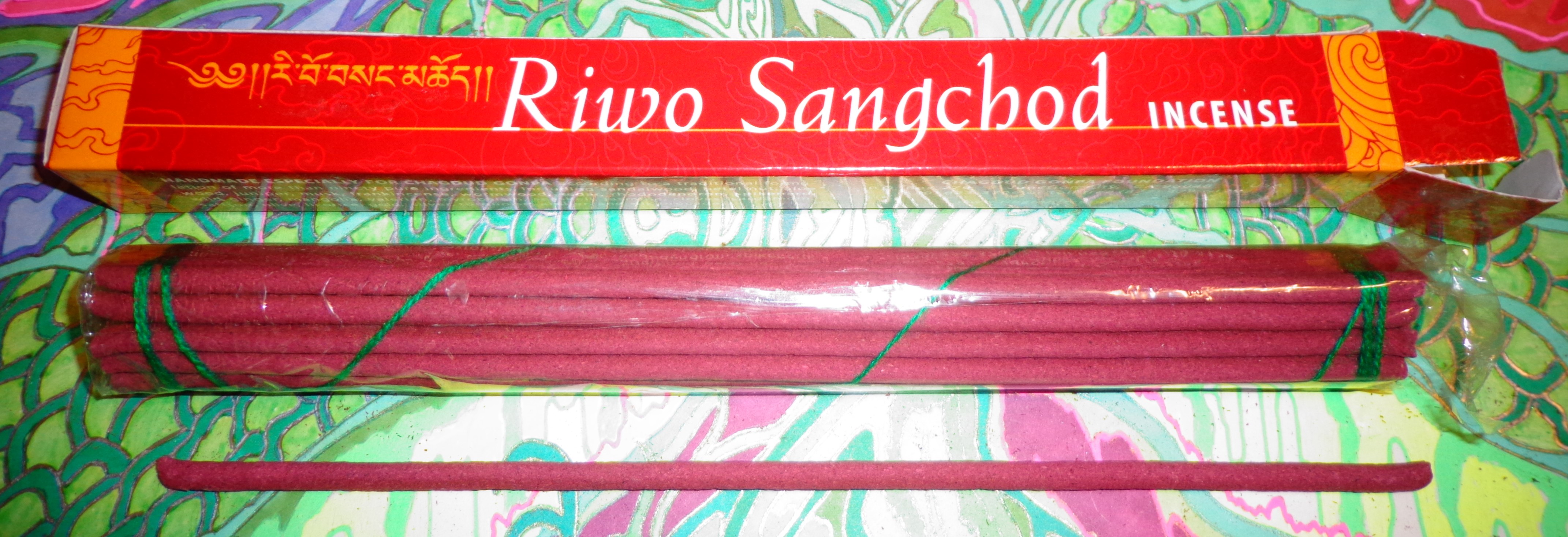 Riwo Sangchod reminds me most of the Tashi Lhunpo Shing Kham Kun Khyab red stick I reviewed almost 16 years ago, although since it’s been that long I would imagine this one isn’t quite as deluxe. It’s possibly the Nepali equivalent of a Bhutani red stick (there are two Riwo Sangchod incenses from Bhutan in the Tibetan Treasures catalog as well) but obviously having a completely different scent profile. It has an impressive list of more than ninety ingredients, including sandalwood, betel nut, aloeswood, juniper, musk, frankincense, wormwood, cedar, rhododendron, spikenard, wild ginger, magnolia, valerian, myrobalan, seashell, jasmine, cloves, cardamom, saffron, olive, licorice, gold, silver, turquoise, amber, and silk brocade. And as you can imagine, with such an impressive list of ingredients (I think this is my first with turquoise or silk brocade!), everything has been blended down to a completely composite aroma, one that is friendly and sweet on top while still having quite a bit of complexity swirling around beneath. Like in Bhutanese incenses, this has characteristics I’d describe as woody and berry-like all at once, it’s clearly not a Tibetan secret to pair these aspects together as they’re always a really friendly match. This isn’t a spectacular incense, I wouldn’t even call any of the Bhutanese equivalents spectacular either, but what they are is light and really accessible. And at least in this case the ingredients feel up to snuff and not at all watered down. Several sticks of this more or less confirmed my static opinion of this one, but keep in mind what I said about the complexity, some of the subscents churn underneath and show up in different temperatures so this one isn’t being phoned in. The subtle woodiness is quite nice here.
Riwo Sangchod reminds me most of the Tashi Lhunpo Shing Kham Kun Khyab red stick I reviewed almost 16 years ago, although since it’s been that long I would imagine this one isn’t quite as deluxe. It’s possibly the Nepali equivalent of a Bhutani red stick (there are two Riwo Sangchod incenses from Bhutan in the Tibetan Treasures catalog as well) but obviously having a completely different scent profile. It has an impressive list of more than ninety ingredients, including sandalwood, betel nut, aloeswood, juniper, musk, frankincense, wormwood, cedar, rhododendron, spikenard, wild ginger, magnolia, valerian, myrobalan, seashell, jasmine, cloves, cardamom, saffron, olive, licorice, gold, silver, turquoise, amber, and silk brocade. And as you can imagine, with such an impressive list of ingredients (I think this is my first with turquoise or silk brocade!), everything has been blended down to a completely composite aroma, one that is friendly and sweet on top while still having quite a bit of complexity swirling around beneath. Like in Bhutanese incenses, this has characteristics I’d describe as woody and berry-like all at once, it’s clearly not a Tibetan secret to pair these aspects together as they’re always a really friendly match. This isn’t a spectacular incense, I wouldn’t even call any of the Bhutanese equivalents spectacular either, but what they are is light and really accessible. And at least in this case the ingredients feel up to snuff and not at all watered down. Several sticks of this more or less confirmed my static opinion of this one, but keep in mind what I said about the complexity, some of the subscents churn underneath and show up in different temperatures so this one isn’t being phoned in. The subtle woodiness is quite nice here. Perhaps even more impressive than the Riwo Sangchod is Chagdud Gonpa Foundations’s Unsurpassable Healing Incense, one of the few Nepali incenses that actually approaches the level of some of the better Tibetan incenses. Thanks to the categories here I found that this was also in Anne’s Top 10 in 2011! It has a similar ingredient profile to the Riwo Sangchod, with juniper, white and red sandalwood, saffron, valerian, magnolia, musk, aloeswood, myrobalan, olive, jasmine, clove, rhododendron, powdered seashell, frankincense, licorice, cuttlefish bone, wild ginger, betel nut, and powdered alabaster, but even though there are some similarities to the berry/woody mix of that incense, the ingredients add up to something a lot more complex. The first thing I get is some top layer of peppery spice. Second the middle with the woods and saffron. There’s definitely some musk in the mix which is almost entirely absent or at least not noticeably present in most Nepali incenses. As the smoke spreads out more of the incense’s floral notes come out a bit more as well as what seems like a bit of an agarwood note. It only remains noticeably Nepalese by the base which, despite all the other ingredients, still seems a bit (too?) high in juniper or some other cheap sawdust content. Also present are some of the notes found in the Riwo Sangchod as if the incense fractalizes at times. Ultimately there is really a lot going on this one and it can be intensely fascinating to realize that it might take some time to see it at as recognizable rather than ever-changing. In fact I really liked Anne’s description of this as an “all rounder,” it’s almost the perfect way to summarize it in a couple of words. Recommended for the patient.
Perhaps even more impressive than the Riwo Sangchod is Chagdud Gonpa Foundations’s Unsurpassable Healing Incense, one of the few Nepali incenses that actually approaches the level of some of the better Tibetan incenses. Thanks to the categories here I found that this was also in Anne’s Top 10 in 2011! It has a similar ingredient profile to the Riwo Sangchod, with juniper, white and red sandalwood, saffron, valerian, magnolia, musk, aloeswood, myrobalan, olive, jasmine, clove, rhododendron, powdered seashell, frankincense, licorice, cuttlefish bone, wild ginger, betel nut, and powdered alabaster, but even though there are some similarities to the berry/woody mix of that incense, the ingredients add up to something a lot more complex. The first thing I get is some top layer of peppery spice. Second the middle with the woods and saffron. There’s definitely some musk in the mix which is almost entirely absent or at least not noticeably present in most Nepali incenses. As the smoke spreads out more of the incense’s floral notes come out a bit more as well as what seems like a bit of an agarwood note. It only remains noticeably Nepalese by the base which, despite all the other ingredients, still seems a bit (too?) high in juniper or some other cheap sawdust content. Also present are some of the notes found in the Riwo Sangchod as if the incense fractalizes at times. Ultimately there is really a lot going on this one and it can be intensely fascinating to realize that it might take some time to see it at as recognizable rather than ever-changing. In fact I really liked Anne’s description of this as an “all rounder,” it’s almost the perfect way to summarize it in a couple of words. Recommended for the patient.
 As far as I can tell some sense of artemisia or wormwood is likely causing what a lot of Westerners might find a funky note, but unlike Dzongsar Monastery this doesn’t go funky on a deeper level due to the dryness. This means that whatever central woods are at work, likely the usual, say, red and white sandalwood, are also fairly drowned out here and you’re largely left with an herbal blast more similar to cooking than aromatics. The dryness is sort of more in the grass to hay range as well, which ekes out a little different territory to other contiguous Tibetans. There is no big musk hit or deep spiciness and absolutely no escape from the major herbal presence, and it does have that strange feel of some expensive and challenging gourmand cheese cooking in a brick oven on a pizza. There are very few Tibetans that I find actively difficult, unfortunately this is probably one of them as I’ve never gotten used to this particular herbal presence.
As far as I can tell some sense of artemisia or wormwood is likely causing what a lot of Westerners might find a funky note, but unlike Dzongsar Monastery this doesn’t go funky on a deeper level due to the dryness. This means that whatever central woods are at work, likely the usual, say, red and white sandalwood, are also fairly drowned out here and you’re largely left with an herbal blast more similar to cooking than aromatics. The dryness is sort of more in the grass to hay range as well, which ekes out a little different territory to other contiguous Tibetans. There is no big musk hit or deep spiciness and absolutely no escape from the major herbal presence, and it does have that strange feel of some expensive and challenging gourmand cheese cooking in a brick oven on a pizza. There are very few Tibetans that I find actively difficult, unfortunately this is probably one of them as I’ve never gotten used to this particular herbal presence. This is the final installment for the most recent batch of Epika Earth incenses I received in my most recent Etsy order. They have so, so many more sticks and other goodies at their actual website and I am absolutely sure I liked most of their offerings enough to go for another order again in the future. There is something really warm and comforting about a lot of them. Perhaps its because so many of their incenses are essential oil mixes, but I like how these often create almost mythical libations, like you’re holding some amazing drink in your hand. The last group of these incenses are a couple that look like they are part of a Sacred line, a couple that are not part of any line and look like standards, and then a few backflow cones were also sent which are a bit more difficult to talk about as I don’t like the format while on the other hand these would likely be tremendously good cones if they weren’t.
This is the final installment for the most recent batch of Epika Earth incenses I received in my most recent Etsy order. They have so, so many more sticks and other goodies at their actual website and I am absolutely sure I liked most of their offerings enough to go for another order again in the future. There is something really warm and comforting about a lot of them. Perhaps its because so many of their incenses are essential oil mixes, but I like how these often create almost mythical libations, like you’re holding some amazing drink in your hand. The last group of these incenses are a couple that look like they are part of a Sacred line, a couple that are not part of any line and look like standards, and then a few backflow cones were also sent which are a bit more difficult to talk about as I don’t like the format while on the other hand these would likely be tremendously good cones if they weren’t. So first of all we have the Celebration of Life stick (part of the Sacred line), which is different but obviously related in an aromatic way to the
So first of all we have the Celebration of Life stick (part of the Sacred line), which is different but obviously related in an aromatic way to the 
 The
The 
 Epika Earth were also kind enough to send no less than three different kinds of backflow cones. As I offered to review their incenses prior to their seeing the information on our website, I thought I’d use this opportunity to talk about these types of cones first as they’ve grown in popularity since they started showing up however many years back. The simple idea for a backflow cone is a hole is drilled down the center and “something” is added to the mix in order to make the smoke heavy enough to come down through the hole and drift slowly down any number of artistically designed backflow holders. It’s absolutely understandable why people would think this is cool, as smoke pouring from a ceramic chimney or dragon’s mouth is a neat effect. I even bought a cool dragon backflow holder which I managed to break in the middle of these reviews, chipping off just the right spot (one of the dragon wings) that should have held the smoke in. But the thing is, even in practice you have to do a lot of shifting and have a lot of patience for the smoke of a burning backflow cone to make it all the way down to the bottom of a cascade. For me the smoke never got farther than the first slide after the dragon’s mouth and I think I got one cone to get all the way down to the bottom once.
Epika Earth were also kind enough to send no less than three different kinds of backflow cones. As I offered to review their incenses prior to their seeing the information on our website, I thought I’d use this opportunity to talk about these types of cones first as they’ve grown in popularity since they started showing up however many years back. The simple idea for a backflow cone is a hole is drilled down the center and “something” is added to the mix in order to make the smoke heavy enough to come down through the hole and drift slowly down any number of artistically designed backflow holders. It’s absolutely understandable why people would think this is cool, as smoke pouring from a ceramic chimney or dragon’s mouth is a neat effect. I even bought a cool dragon backflow holder which I managed to break in the middle of these reviews, chipping off just the right spot (one of the dragon wings) that should have held the smoke in. But the thing is, even in practice you have to do a lot of shifting and have a lot of patience for the smoke of a burning backflow cone to make it all the way down to the bottom of a cascade. For me the smoke never got farther than the first slide after the dragon’s mouth and I think I got one cone to get all the way down to the bottom once. The second installment of Epika Earth incenses are a group of incenses labelled Artisan, three sticks and one incense in “dhoop” form. Based on a different incense on the line, Epika Earth describe these: “Our artisan blends are made entirely with natural ingredients that include essential oils, extracts, resinoids, woods and herbs. While creating the extracts, essential oils and crafting our artisan blends we use our own proprietary methods to protect and maximize the aroma of the ingredients in order to bring you the pure scents of earth in incense form.”
The second installment of Epika Earth incenses are a group of incenses labelled Artisan, three sticks and one incense in “dhoop” form. Based on a different incense on the line, Epika Earth describe these: “Our artisan blends are made entirely with natural ingredients that include essential oils, extracts, resinoids, woods and herbs. While creating the extracts, essential oils and crafting our artisan blends we use our own proprietary methods to protect and maximize the aroma of the ingredients in order to bring you the pure scents of earth in incense form.”



 I consider Tibetan incenses that reach the $20 mark or go over to usually consist of ingredients that denote a more premium incense and certainly more so if the box is half the size of a usual roll as is the case with
I consider Tibetan incenses that reach the $20 mark or go over to usually consist of ingredients that denote a more premium incense and certainly more so if the box is half the size of a usual roll as is the case with  The Golden Essence comes in a very nice box, something that says premium from the get-go, especially with inner gold colored foil wrapper, which is quite a change from the containerless Sacred Mountains roll. The notes here are “frankincense, nutmeg, agarwood, rhododendron and other precious ingredients.” While the frankincense is not particularly obvious in the mix at first, it absolutely blends in to create a very different vibe from the usual incenses with nutmeg and agarwood. The base does smell like there may be some sandalwood in there mixed in with the agarwood, but on top of the wood the frankincense seems to intensify the herbal and spice mix – it comes off a bit tangy and a touch brassy. It wasn’t until my fourth stick that I actually started feeling like the agarwood in this was pretty good and actually contributing to the quality of the aroma rather than being a milder base wood. It is absolutely a vital part of the scent.
The Golden Essence comes in a very nice box, something that says premium from the get-go, especially with inner gold colored foil wrapper, which is quite a change from the containerless Sacred Mountains roll. The notes here are “frankincense, nutmeg, agarwood, rhododendron and other precious ingredients.” While the frankincense is not particularly obvious in the mix at first, it absolutely blends in to create a very different vibe from the usual incenses with nutmeg and agarwood. The base does smell like there may be some sandalwood in there mixed in with the agarwood, but on top of the wood the frankincense seems to intensify the herbal and spice mix – it comes off a bit tangy and a touch brassy. It wasn’t until my fourth stick that I actually started feeling like the agarwood in this was pretty good and actually contributing to the quality of the aroma rather than being a milder base wood. It is absolutely a vital part of the scent.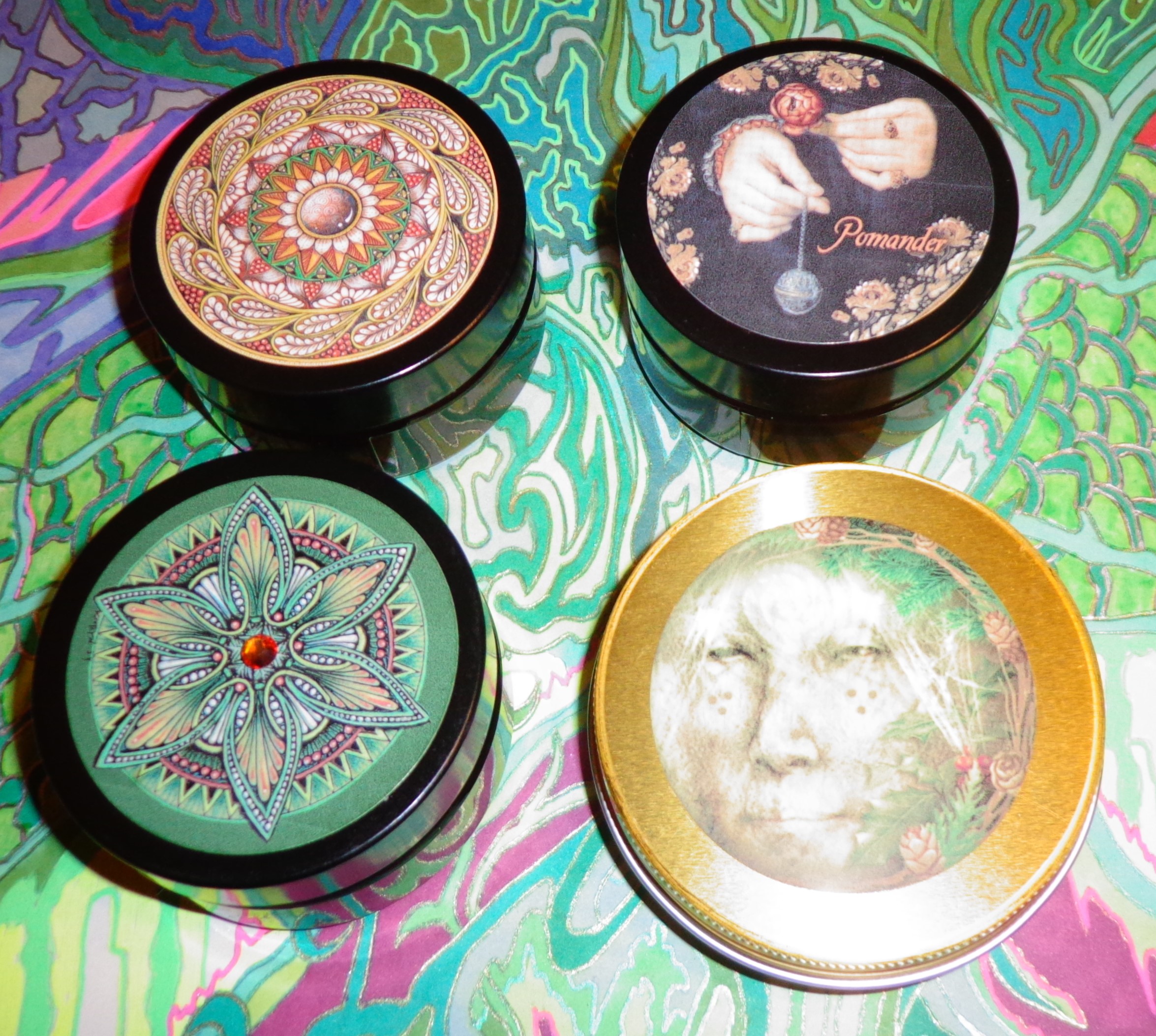
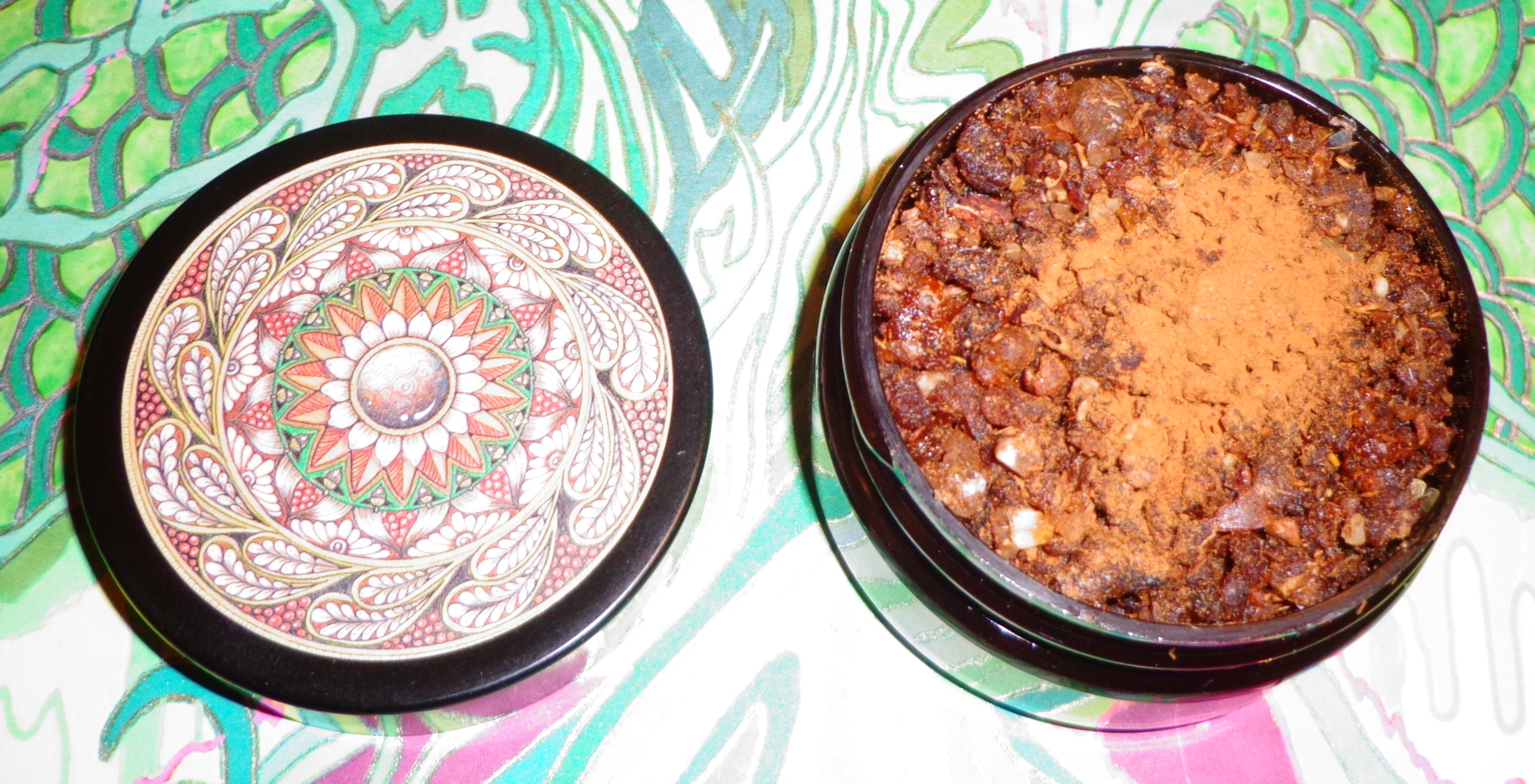 But before we get to the winter incenses, let’s pop back to the autumn for Mermade’s
But before we get to the winter incenses, let’s pop back to the autumn for Mermade’s 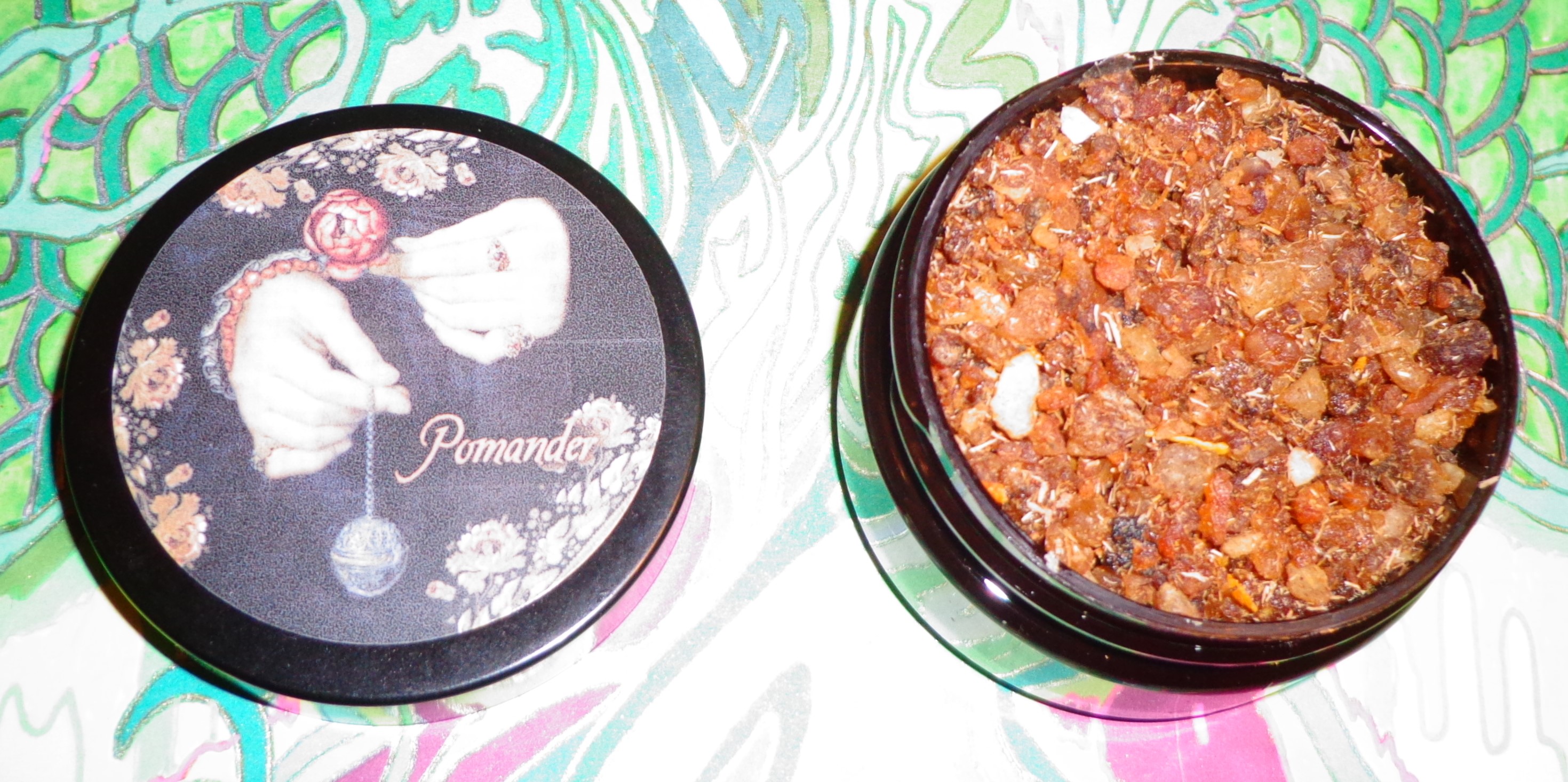 I have probably brought this up before (I seem to remember doing so recently with the Temple of Incense Festive Kiss which is certainly in the same spirit) but one of my early memories was a recipe my mom made called “spiced tea.” It was a very 70s sort of thing with Tang powder, Lipton tea and spices. It had loads of sugar and smelled amazing so of course I loved it. Mermade’s
I have probably brought this up before (I seem to remember doing so recently with the Temple of Incense Festive Kiss which is certainly in the same spirit) but one of my early memories was a recipe my mom made called “spiced tea.” It was a very 70s sort of thing with Tang powder, Lipton tea and spices. It had loads of sugar and smelled amazing so of course I loved it. Mermade’s 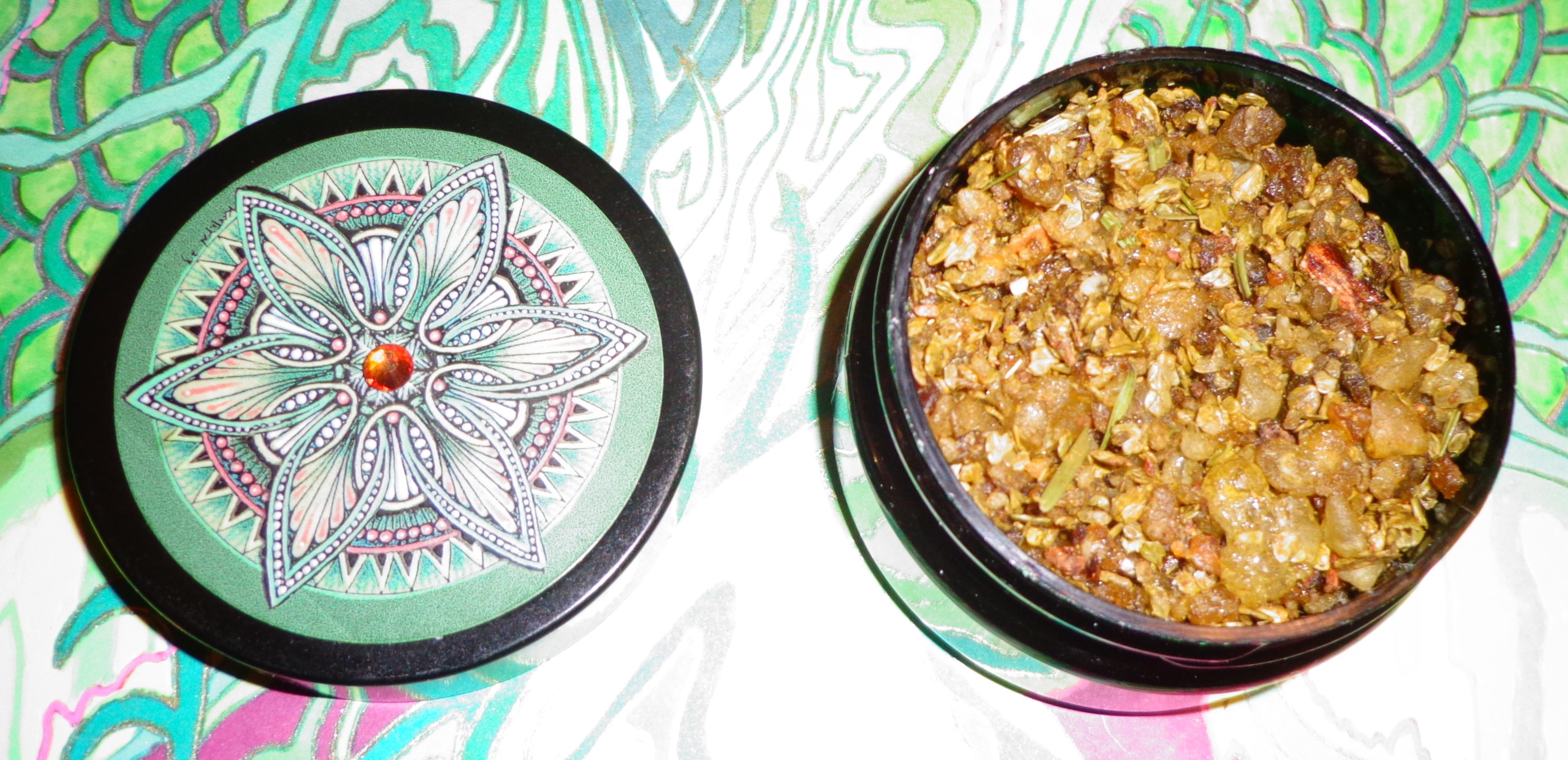
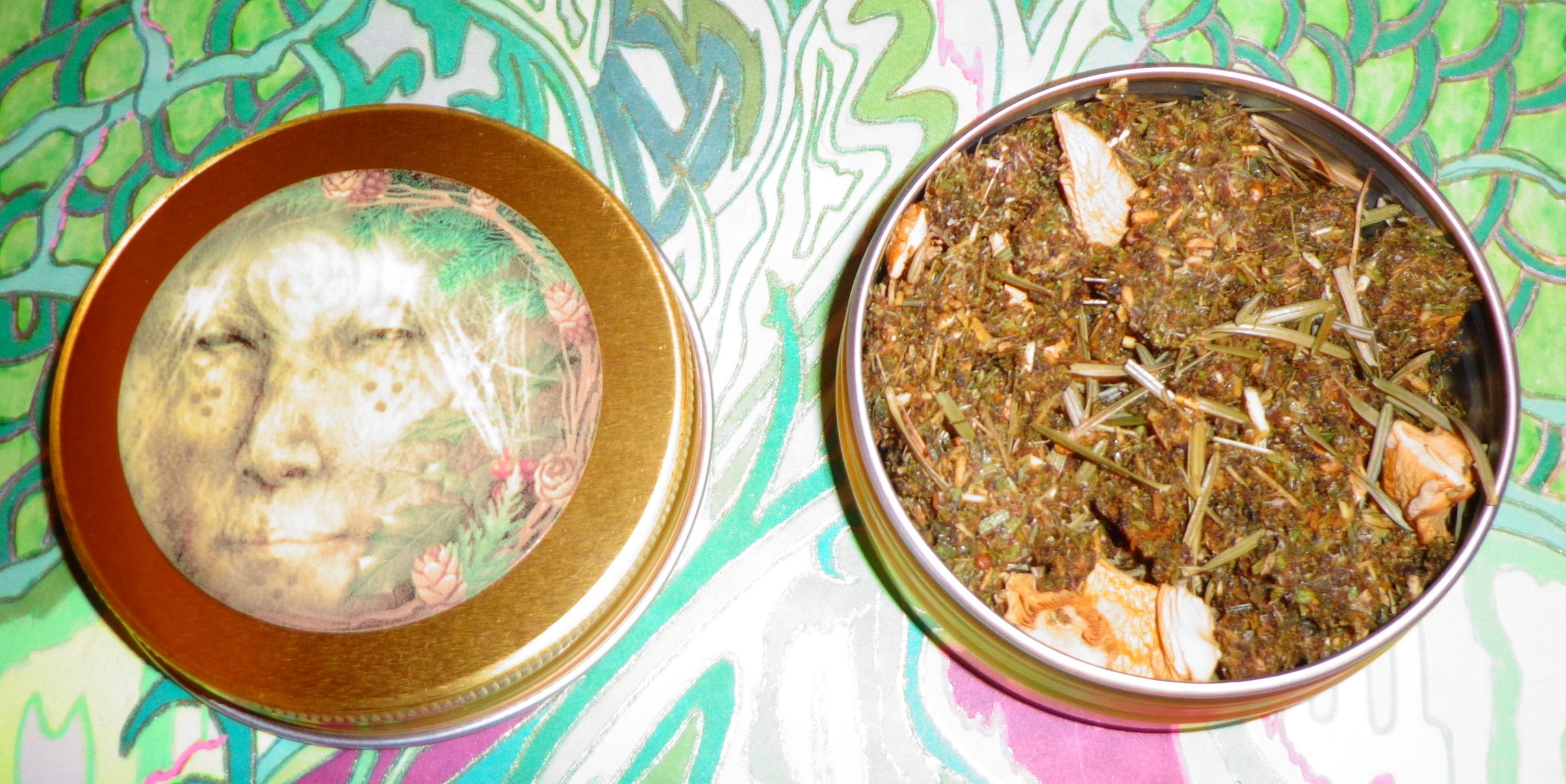 And not terribly far from Winter Wreath is the Espirit de la Nature offering
And not terribly far from Winter Wreath is the Espirit de la Nature offering  I get pretty thrilled when Incense Traditions brings in a new monastery (or nunnery) incense, most of them are just amazing aromatic experiences and so few of them are repetitive or boring. It’s even nicer when it’s a wonderful new monastery incense with a low price on it.
I get pretty thrilled when Incense Traditions brings in a new monastery (or nunnery) incense, most of them are just amazing aromatic experiences and so few of them are repetitive or boring. It’s even nicer when it’s a wonderful new monastery incense with a low price on it.  Reting Monastery incense just has really deep spices to it, they’re as latent as the woods or resins in the mix, but they rise all the way up to the top without feeling adulterated. As someone who loves deep cinnamon/nutmeg/clove sorts of mixes, I was very impressed with how powerful these notes are in this incense, and I think it’s easy to catch the black cardamom in this as well (my initial notes show that I found the nutmeg to be really in front as well). However, the spice profile isn’t say like a spiced cookie or particularly sweet, but in this case it takes all that in a really fresh direction. Where a lot of monastery incenses might go in a deeply tangy direction, you get that as a sub-note underneath all the spicy glory of this beauty. It is actually astonishing at times what spirals off of the smoke and it’s a testament that so many of these incenses really need a deep dive first as it’s hard to catch everything with just a stick or two. I believe I bought this earlier in the year and did like it but when I sat down to review this in the morning, it really clicked with me. If I was to compare it to other incenses, it is similar in some base-like fashion to some of the therapeutic and relaxation category on the IT website, for instance there is a bit of that like pistachio-like aroma you find in the Holy Lands. The musk feels even more latent in this incense, at times I don’t even notice it because of the spices, but then it just kind of wallops you. An absolutely outstanding incense and a tremendous find, it’s just a cavalcade of multiple sub-notes and surprises.
Reting Monastery incense just has really deep spices to it, they’re as latent as the woods or resins in the mix, but they rise all the way up to the top without feeling adulterated. As someone who loves deep cinnamon/nutmeg/clove sorts of mixes, I was very impressed with how powerful these notes are in this incense, and I think it’s easy to catch the black cardamom in this as well (my initial notes show that I found the nutmeg to be really in front as well). However, the spice profile isn’t say like a spiced cookie or particularly sweet, but in this case it takes all that in a really fresh direction. Where a lot of monastery incenses might go in a deeply tangy direction, you get that as a sub-note underneath all the spicy glory of this beauty. It is actually astonishing at times what spirals off of the smoke and it’s a testament that so many of these incenses really need a deep dive first as it’s hard to catch everything with just a stick or two. I believe I bought this earlier in the year and did like it but when I sat down to review this in the morning, it really clicked with me. If I was to compare it to other incenses, it is similar in some base-like fashion to some of the therapeutic and relaxation category on the IT website, for instance there is a bit of that like pistachio-like aroma you find in the Holy Lands. The musk feels even more latent in this incense, at times I don’t even notice it because of the spices, but then it just kind of wallops you. An absolutely outstanding incense and a tremendous find, it’s just a cavalcade of multiple sub-notes and surprises. As introduced in my previous review,
As introduced in my previous review,  Asayu’s
Asayu’s 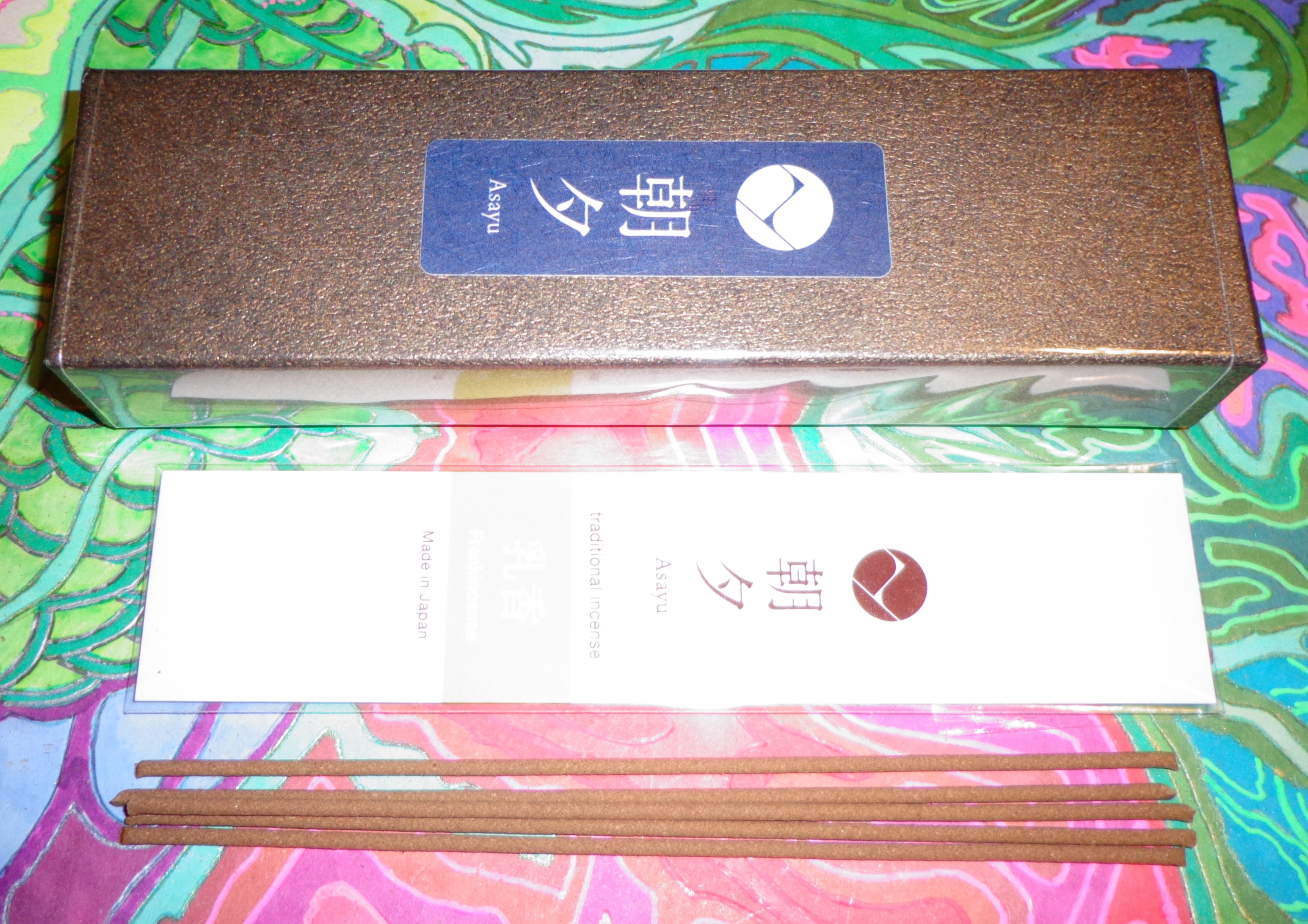 But let’s start with the two traditionals. One is a
But let’s start with the two traditionals. One is a  Hinoki (Cypress) incenses are actually very difficult not to do well, even the inexpensive
Hinoki (Cypress) incenses are actually very difficult not to do well, even the inexpensive  So, part of my struggle with low smoke incenses is they can be hard to pick up in my smoke saturated environment or maybe my nose struggles to pick up something this quiet. The Asayu
So, part of my struggle with low smoke incenses is they can be hard to pick up in my smoke saturated environment or maybe my nose struggles to pick up something this quiet. The Asayu  What about the
What about the 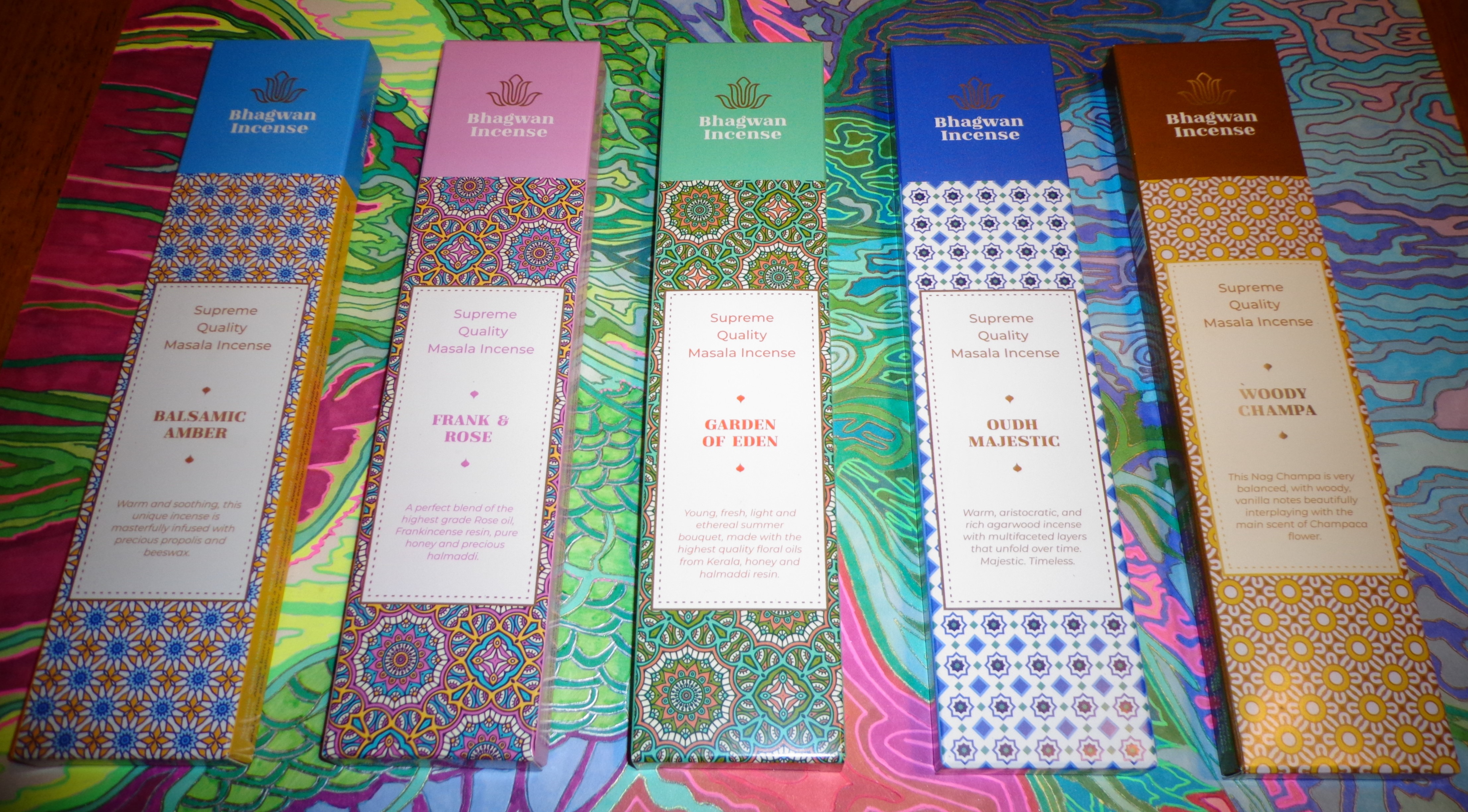
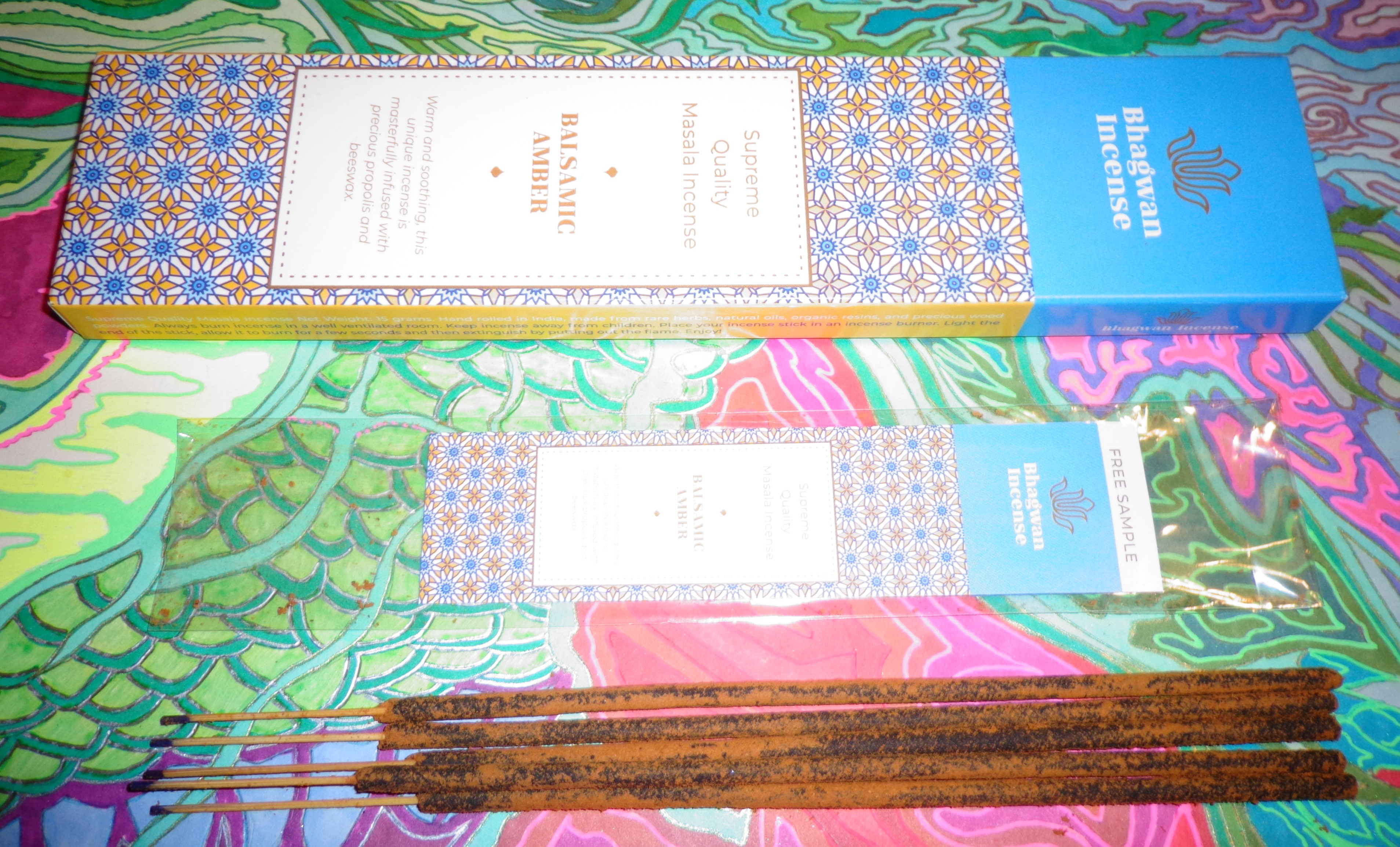
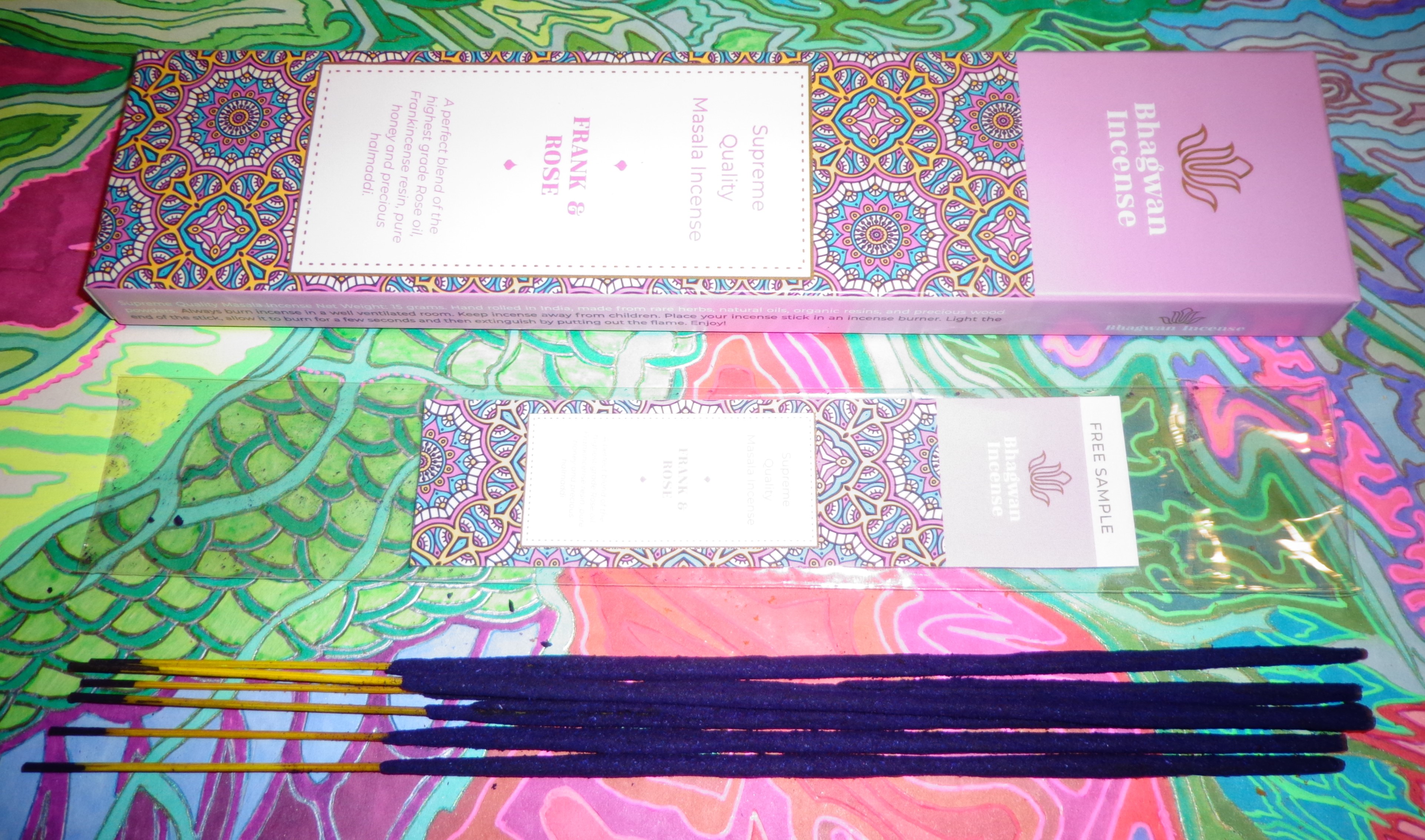 I was expecting
I was expecting 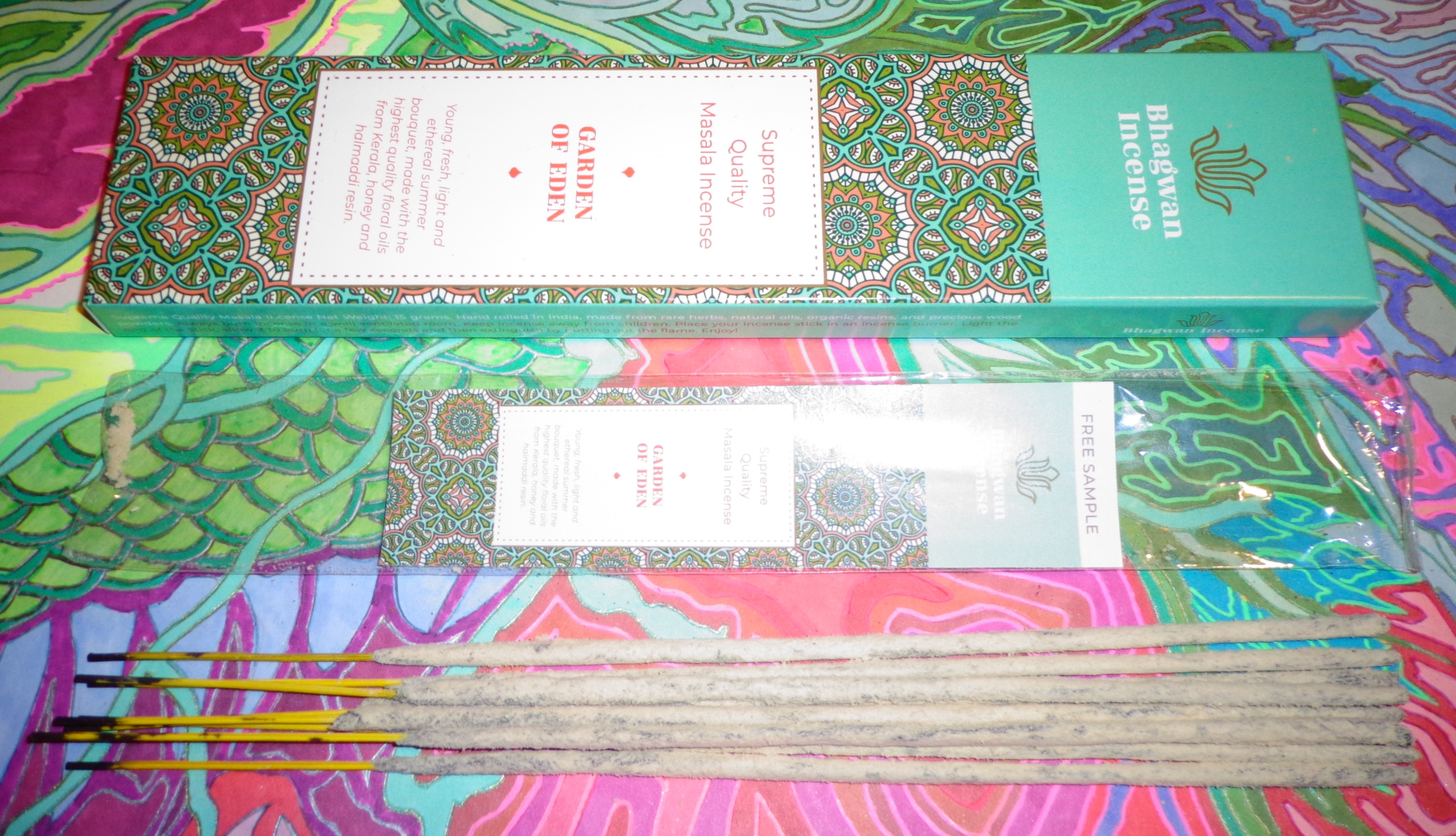 Of the five incenses here, I’m not completely sure of the provenance of each, but
Of the five incenses here, I’m not completely sure of the provenance of each, but 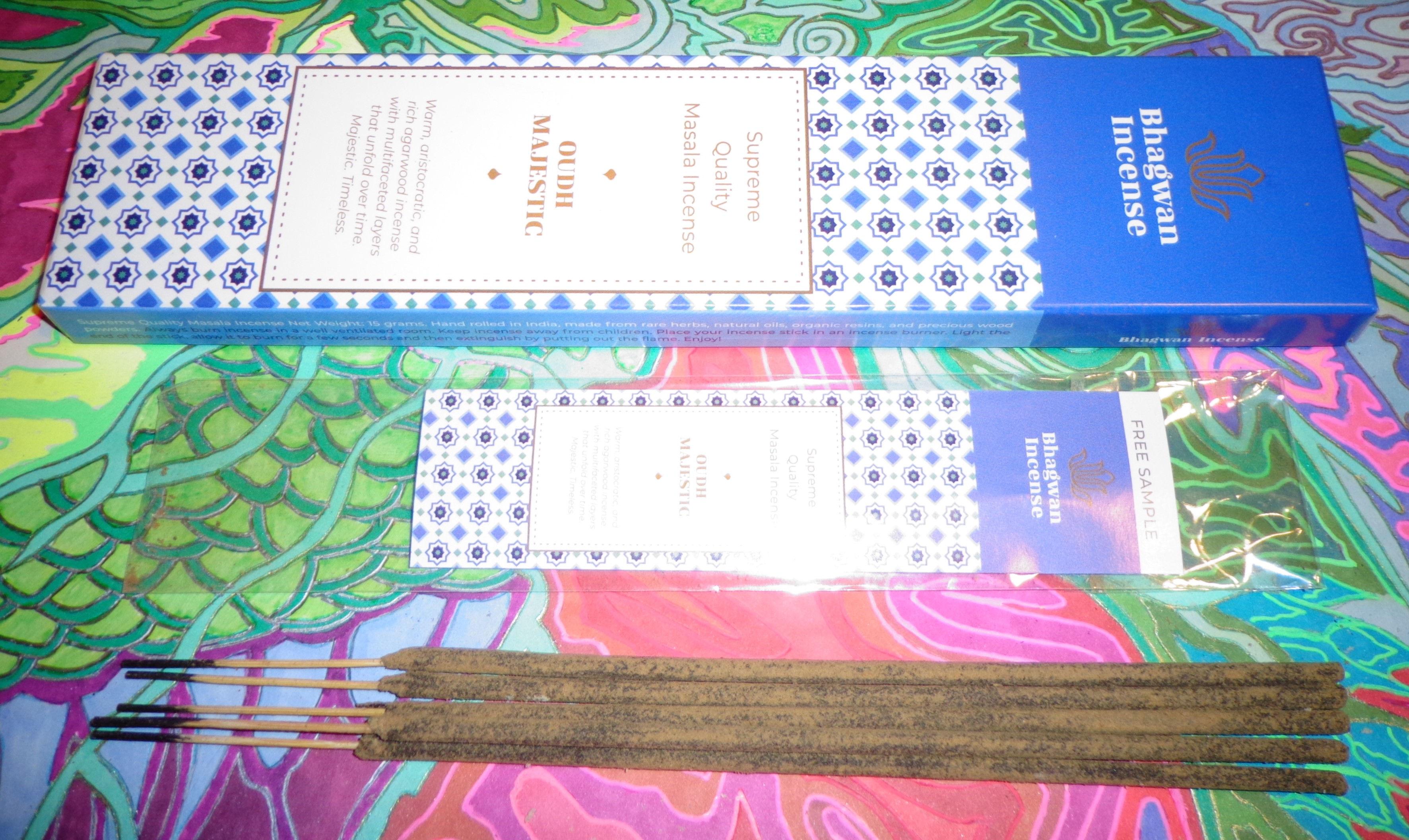 It’s been a long time since there was a real contender to the Oud Masala from the Happy Hari family, that nearly perfect blend of masala base and at least an approximation of a decent oud to complement it. There are also a number of charcoal based ouds out there that one might not be able to pick out a specific aroma in a line up. Pure Incense have provided a wide and almost dizzying array of oud and aloeswood incenses from Madhavadas and often the issue is less the top oils than the base. I’m not sure where
It’s been a long time since there was a real contender to the Oud Masala from the Happy Hari family, that nearly perfect blend of masala base and at least an approximation of a decent oud to complement it. There are also a number of charcoal based ouds out there that one might not be able to pick out a specific aroma in a line up. Pure Incense have provided a wide and almost dizzying array of oud and aloeswood incenses from Madhavadas and often the issue is less the top oils than the base. I’m not sure where 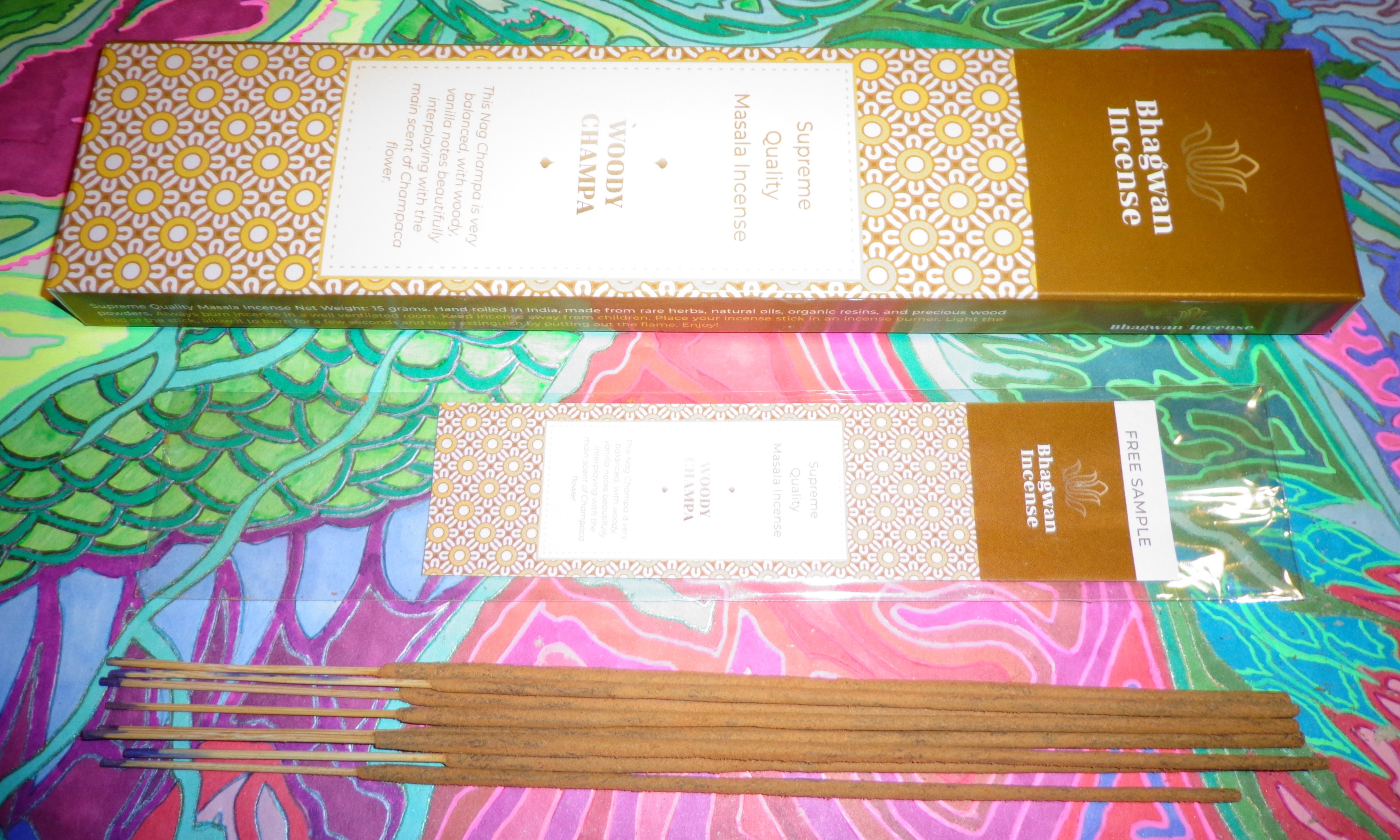 Finally, in this group, is the somewhat humble
Finally, in this group, is the somewhat humble  For lack of a better definition, I find it fascinating that “boutique” smaller shop incense creators are not only working on new scents but improving or altering old scents. Voyager was
For lack of a better definition, I find it fascinating that “boutique” smaller shop incense creators are not only working on new scents but improving or altering old scents. Voyager was  First of all, Josh has explained to me that there’s a choice in the creation between the amount of binder in a stick and the choice of the more intense scent when there is less of this binder. In that sense, this is probably as far over to the intense scent side, leaving the sticks extremely fragile (more so than other comparable D5 sticks). Like just now I lit a fragment and as I held it the top half that was burning fell off! So keep that in mind, although I will say at this level you definitely do not get much in the way, if at all, of binder materials in the aroma. It is de-luxe. This new version of Voyager is thus a very pure scent and it also burns quite fast. First of all what I notice in this is this sort of an apple juice or apple cider type of scent which I think is largely due to the mix of woods as well as the cinnamon in the mix. So even before looking at my old review I am sensing something quite familiar somewhere in my scent memory. Now if I remember correctly, I don’t believe the original has this strength which brings out more of the sort of lacquer like qualities you get in better aloeswood. They are definitely being coaxed out here a bit more. It feels as well like the frankincense and camphor both merge nicely into mix, the camphor is actually on the edges of this in the best way. As the burn deepens, the aloeswood qualities really come out to the fore, giving a richness to the overall aroma. I might add too that I had to step out of my place for ten minutes, when I came back the area around my burner was still quite resonant of the scent of the incense, there’s no question there’s some level of strength going on in this.
First of all, Josh has explained to me that there’s a choice in the creation between the amount of binder in a stick and the choice of the more intense scent when there is less of this binder. In that sense, this is probably as far over to the intense scent side, leaving the sticks extremely fragile (more so than other comparable D5 sticks). Like just now I lit a fragment and as I held it the top half that was burning fell off! So keep that in mind, although I will say at this level you definitely do not get much in the way, if at all, of binder materials in the aroma. It is de-luxe. This new version of Voyager is thus a very pure scent and it also burns quite fast. First of all what I notice in this is this sort of an apple juice or apple cider type of scent which I think is largely due to the mix of woods as well as the cinnamon in the mix. So even before looking at my old review I am sensing something quite familiar somewhere in my scent memory. Now if I remember correctly, I don’t believe the original has this strength which brings out more of the sort of lacquer like qualities you get in better aloeswood. They are definitely being coaxed out here a bit more. It feels as well like the frankincense and camphor both merge nicely into mix, the camphor is actually on the edges of this in the best way. As the burn deepens, the aloeswood qualities really come out to the fore, giving a richness to the overall aroma. I might add too that I had to step out of my place for ten minutes, when I came back the area around my burner was still quite resonant of the scent of the incense, there’s no question there’s some level of strength going on in this.
You must be logged in to post a comment.